
Angkor, also known as Yasodharapura, was the capital city of the Khmer Empire. The city and empire flourished from approximately the 9th to the 15th centuries. The city houses the Angkor Wat, one of Cambodia's most popular tourist attractions.

Wat Phra Kaew, commonly known in English as the Temple of the Emerald Buddha and officially as Wat Phra Si Rattana Satsadaram, is regarded as the most sacred Buddhist temple in Thailand. The complex consists of a number of buildings within the precincts of the Grand Palace in the historical centre of Bangkok. It houses the statue of the Emerald Buddha, which is venerated as the country's palladium.
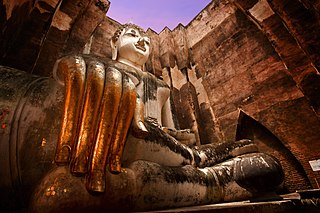
Sukhothai Historical Park covers the ruins of Sukhothai, literally 'dawn of happiness', capital of the Sukhothai Kingdom in the 13th and 14th centuries, in north central Thailand. It is near the city of Sukhothai, capital of Sukhothai Province.
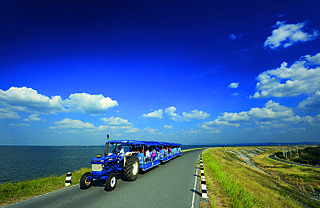
Lopburi is a province in the central region of Thailand. The province is divided into 11 administrative districts, and Mueang Lopburi district is the capital. With over 750,000 people, the province is Thailand's 36th largest area and 32nd most populous. There are eight neighboring provinces, Phetchabun, Chaiyaphum, Nakhon Ratchasima, Saraburi, Phra Nakhon Si Ayutthaya, Ang Thong, Sing Buri, and Nakhon Sawan.
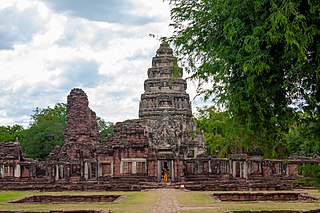
The Phimai Historical Park is a historical park in Thailand, covering the ancient town of Phimai and the ruins of Prasat Phimai Thai: ปราสาทพิมาย, pronounced[prāː.sàːtpʰí(ʔ).māːj]) the largest ancient Khmer temple in Thailand. It is located in the town of Phimai, Nakhon Ratchasima province. It is one of the most important tourist attractions in the province.
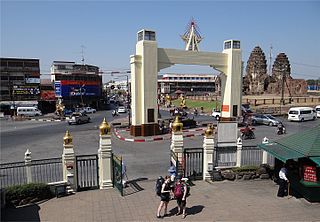
Lopburi is the capital city of Lopburi Province in Thailand. It is about 150 kilometres (93 mi) northeast of Bangkok. It has a population of 58,000. The town covers the whole tambon Tha Hin and parts of Thale Chup Son of Mueang Lopburi District, a total area of 6.85 km2.

Ayutthaya Historical Park covers the ruins of the old city of Ayutthaya, Phra Nakhon Si Ayutthaya Province, Thailand. The city of Ayutthaya was founded by King Ramathibodi I in 1351, though it is likely to be significantly older, based on evidence showing that the area was already populated during the Mon Dvaravati period. Sources further mention that around 850 AD, the Khmers occupied the area and established a stronghold there, naming it Ayodhya, after one of the holiest Hindu cities in India of the same name. The early history of Ayutthaya is connected to this Khmer settlement. Additionally, Prince Damrong has also attested to the existence of a city named Ayodhya, founded by the Khmers ruling from Lopburi at the point where the three rivers meet. An excavation map shows traces of an ancient baray close to the southwestern tip of Wat Yai Chai Mongkhon, which could have been built on a former important Khmer temple complex.

Thai art refers to a diverse range of art forms created in Thailand from prehistoric times to the present day, including architecture, sculpture, painting, textiles, decorative arts, crafts, ceramics, and more. While Buddhism has played a significant role in Thai art, with many sculptures and paintings depicting Buddha images and religious themes, nature, including flora and fauna, as well as mythical creatures, has been a major inspiration for Thai art, with colorful motifs appearing in various types of art forms. In contemporary Thai art, traditional works remain significant and continue to influence artists' concepts.

A prang is a tall tower-like spire, usually richly carved. They were a common shrine element of Hindu and Buddhist architecture in the Khmer Empire (802–1431). They were later adapted by Buddhist builders in Thailand, especially during the Ayutthaya Kingdom (1350–1767) and Rattanakosin Kingdom (1782–1932). In Thailand it appears only with the most important Buddhist temples.

Thai temple art and architecture is the art and architecture of Buddhist temples in Thailand. Temples are known as wats, from the Pāḷi vāṭa, meaning "enclosure". A temple has an enclosing wall that divides it from the secular world.

The architecture of Thailand is a major part of the country's cultural legacy and reflects both the challenges of living in Thailand's sometimes extreme climate as well as, historically, the importance of architecture to the Thai people's sense of community and religious beliefs. Influenced by the architectural traditions of many of Thailand's neighbors, it has also developed significant regional variation within its vernacular and religious buildings. Although Siam urged to identify themselves as a modernized state, Western culture and influence was undesirable and inevitable. In an attempt to become distinguished, Thailand's ruling elite gravitated toward selective Modernization to avoid the undesired Western influence.

Known as "Lavo" during most of its history, Lopburi Province is one of the most important cities in the history of Thailand. The city has a long history, dating back into the prehistory period since the Bronze Age of more than 3,500 years ago.

Wat Phra That Phanom is a Buddhist temple in the That Phanom District in the south of Nakhon Phanom Province, all within the Isan region of Thailand near the Lao border. According to local legend, the temple contains in the pagoda the Phra Uranghathat (พระอุรังคธาตุ)/Phra Ura (พระอุระ)/Buddha's breast bones. As such, it is one of the most important structures for Theravada Buddhists and the most important Buddhist site in the province, with an annual week-long festival being held in the town of That Phanom to honour the temple. These festival attract thousands of people who make pilgrimages to the shrine. In Thai folk Buddhism, Wat Phra That Phanom is a popular pilgrimage destination for those born in the year of the Monkey.

The Si Satchanalai Historical Park is a historical park in Si Satchanalai district, Sukhothai Province, northern Thailand. The park covers the ruins of Si Satchanalai and Chaliang. Si Satchanalai, which literally means "City of good people", was founded in 1250 as the second center of the Sukhothai Kingdom and as a residence of the crown prince in the 13th and 14th centuries.

The Lavo Kingdom was a political entity (mandala) on the left bank of the Chao Phraya River in the Upper Chao Phraya valley from the end of Dvaravati civilization, in the 7th century, until 1388. The original center of Lavo civilization was Lavo, but the capital shifted southward to Ayodhaya, the port city on the right side of the Ayutthaya island around the 11th century, whereupon the state was incorporated into the Ayutthaya Kingdom in the 14th century.
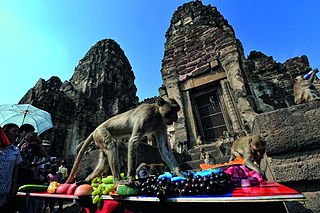
The Monkey Buffet Festival is held annually in Lopburi, Thailand. In 2007, the festival included giving fruits and vegetables to the local monkey population of 2,000 crab-eating macaques in Lopburi Province north of Bangkok.
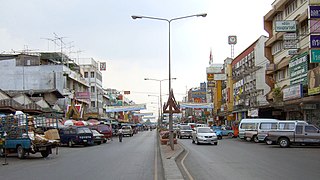
Phra Nakhon Si Ayutthaya, or locally and simply Ayutthaya is the capital of Phra Nakhon Si Ayutthaya province of Thailand. Ayutthaya was the capital of the Ayutthaya kingdom. Located on an island at the confluence of the Chao Phraya and Pa Sak rivers, Ayutthaya is the birthplace of the founder of Bangkok, King Rama I. The ruins of the old city are preserved in the Ayutthaya Historical Park.
Arogayasala, or Arogyashala, are temple structures found in Cambodia and North-Eastern Thailand dating to the Khmer Empire. These Arogayasala served as medical facilities and are attributed to King Jayavarman VII whose reign lasted from c.1181 to c.1218.


















